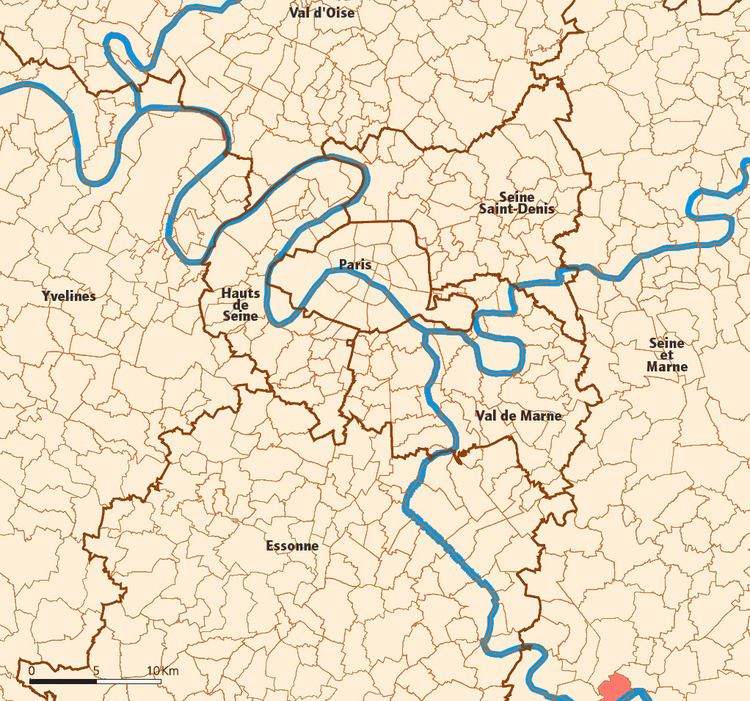Le Mée-sur-Seine is a commune in the Seine-et-Marne department in the Île-de-France region in north-central France. It is located in the south-eastern suburbs of Paris 41.1 km (25.5 mi) from the center.
The town is located on the ride side of the Seine on a limestone plateau.
B.C. : the Sénons (Gaul tribe) may have lived here.13th century : Le Mée-sur-Seine is mentioned for the first time by "Mas" in 1253. A "Mas" is an old French term for farm.15th century : castle of "Marchémarais"September, 30th, 1833 : birth of Henri Chapu, a famous sculptor.1889 : construction of the "Eglise Notre-Dame-de-la-Nativité".1845 : first railway.1938 : Originally called simply "Le Mée", the name of the commune became officially "Le Mée-sur-Seine" (meaning "Le Mée upon Seine")1944 : Release of the town by the allied troops who crossed over the Seine using a float-bridge (the only bridge had been destroyed by the Germans).1970-1971 : construction of the main road to Melun (« la pénétrante »).1979 : opening of the new rail station.The town grew quickly after the World War II and it is now divided in four districts: Le Mée Village, Plein Ciel, Croix Blanche, Les Courtilleraies.
Inhabitants are called Méens.
There are 11 infant schools, 8 garde schools, 2 secondary schools and 1 high school.
"Le Mas": library and auditorium."Espace Cordier": Youth House for Culture."Eglise Notre-Dame-de-la-Nativité" ("Village" District), built from 1889 to 1893, is on the location of the previous church (built in 1771).chapel "Sainte-Croix" ("Croix-Blanche" District)Unemployment rate (1999) : 12,8%Private income (2004) : €15,136/ yLe Mée-sur-Seine is served by Le Mée station on Paris RER line , approximately 45 minutes from the centre of Paris. Local bus network: Bus TRAM: lines B, F, J, J1, M.
Jacques Philippe Avice (1759–1835), general, and also tile maker around 1820.François-Joseph Talma (1763–1826), actor, he was also co-owner of the tile manufactory.Mademoiselle Mars (1779–1847), actress, she was also co-owner of the tile manufactory.Charles-Tristan de Montholon (1782–1853), general and politician, he was also co-owner of the tile manufactory.Grégoire Ghyka (see Grigore Alexandru Ghica (English)(1807–1857), prince of Moldavia (1849–1853 and 1854–1856) lived in "Le Mée," where he committed suicide on August 24th, 1857. His wife and five other relatives are interred close to him in a memorial in the cemetery of the town. Close to this memorial, four other members of the Ghyka family repose (among whom Nicolas Jean Ghika (1849–1873), killed during a duel at Fontainebleau).Henri Chapu, famous sculptor, was born in "Le Mée" in September, 30th, 1833. He was interred on April 24th, 1891.Firmin-Girard (1838–1921), painter. He has been interred close to Henri Chapu.Henri-Auguste Patey (1855–1930), sculptor, student of Henri Chapu.Gaston Carraud (1864–1920), songwriter, student of Jules Massenet, was born in "Le Mée" in July, 20th, 1864.Renée Saint-Cyr (1904–2004), actress, lived in a big 18th century house in "Le Mée".Karl Lagerfeld (1933-), designer, owned a big house in the "Village" District.Caroline de Monaco (1957-) and Ernest-Auguste de Hanovre (1954-) own the house previously occupied by Karl Lagerfeld.Nina Roberts (1979-) ex-porn starWilly Denzey (1982-) singer for teenagers.
